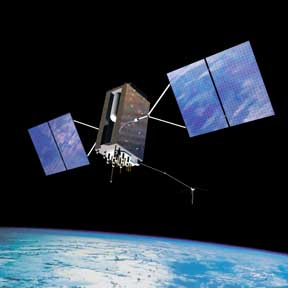 GPS III satellite. Lockheed Martin illustration
GPS III satellite. Lockheed Martin illustrationLockheed Martin announced today (March 15, 2011) that the team it leads in developing the U.S. Air Force’s next-generation GPS III satellites has successfully completed the program’s first major flight-software integration milestone at the company’s software integration laboratory in Newtown, Pennsylvania.
Lockheed Martin announced today (March 15, 2011) that the team it leads in developing the U.S. Air Force’s next-generation GPS III satellites has successfully completed the program’s first major flight-software integration milestone at the company’s software integration laboratory in Newtown, Pennsylvania.
The test event successfully integrated the initial flight software builds and flight-like computer processors for the satellite bus on-board computer (OBC), the navigation payload mission data unit (MDU) and the communications payload thin communications unit (TCU). The successful test demonstrated the ability to communicate between the GPS III satellite bus, network communications, and navigation elements, and is a key step in reducing risk for the program’s flight software development.
Keoki Jackson, Lockheed Martin’s GPS III program manager, said, “Completion of this flight software milestone demonstrates our continued positive momentum and is another step forward in reducing risk and increasing mission assurance for this vital program.”
Working under a $3-billion contract with the Air Force, the GPS III team now turns to work on fully qualifying the flight software prior to its integration on the GPS Non-Flight Satellite Testbed (GNST), which will serve as the program’s ground pathfinder and vehicle demonstrator for the first complete GPS III satellite. The entire GPS III development and production sequence will use the GNST to provide space vehicle design–level validation; early verification of ground, support, and test equipment; and early confirmation and rehearsal of transportation operations.
Having successfully passed the program’s Critical Design Review (CDR) milestone in August 2010, completed more than 50 percent of the program’s manufacturing readiness reviews (MRRs), and now with completion of the first major flight software milestone, Lockheed Martin says the team is on track to deliver the first GPS IIIA spacecraft as planned in 2014.



